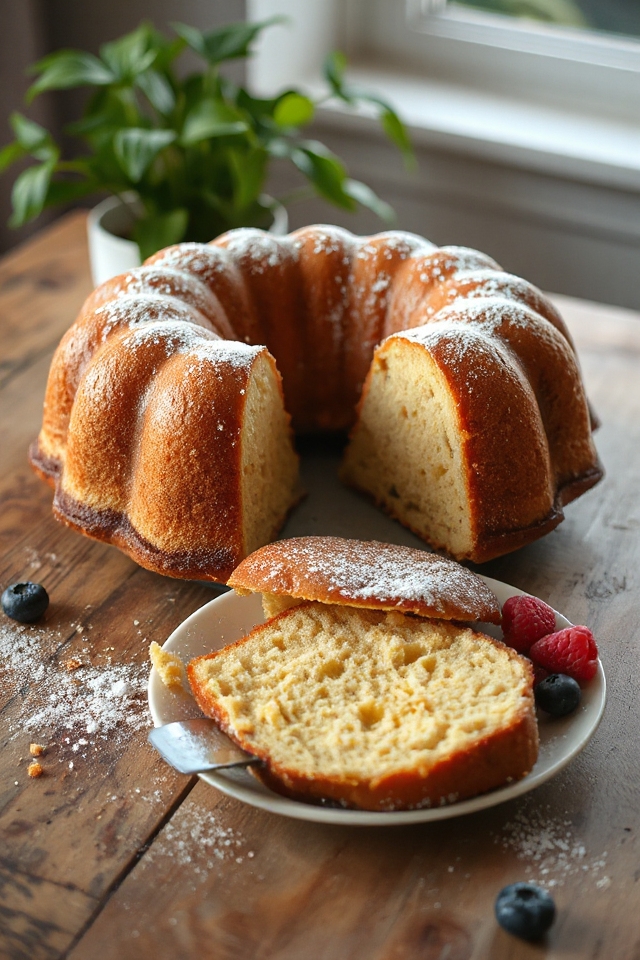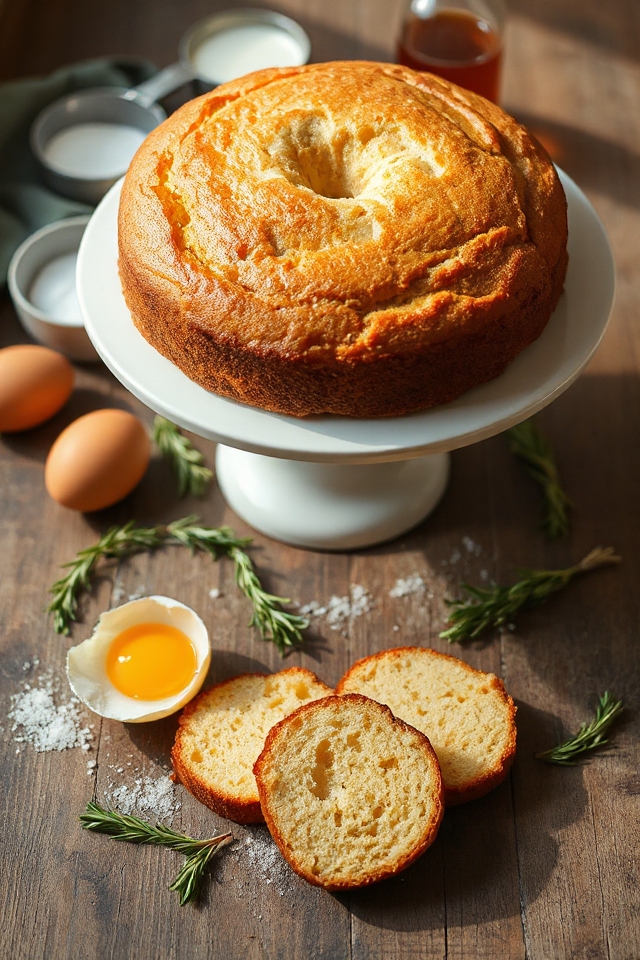Why You’ll Love This Pound Cake Recipe
When you try this pound cake recipe, you’ll immediately appreciate its rich, buttery flavor and moist texture.
I love how simple the process is, making it perfect for both beginners and seasoned bakers.
The cake rises beautifully, creating a delightful crust that contrasts with the tender crumb inside.
Plus, it’s incredibly versatile; you can enjoy it plain, with fresh fruit, or a drizzle of glaze.
It’s the kind of cake that brings people together, whether at a family gathering or a cozy afternoon tea.
Trust me, once you taste it, you’ll want to make it again and again!
Ingredients of Pound Cake
When it comes to making a classic pound cake, the ingredients are pretty straightforward, yet they come together to create something truly special. You don’t need a long list of fancy items; just a few staples that you might already have in your kitchen.
The beauty of pound cake lies in its simplicity, and the rich, buttery flavor is just the cherry on top. So, let’s plunge into what you’ll need to get started on this delicious journey.
Here’s your shopping list:
- 1/2 lb butter (that’s 2 sticks, cool but slightly softened)
- 1/2 cup shortening
- 3 cups sugar
- 5 eggs
- 3 cups all-purpose flour
- 1/2 teaspoon baking powder
- 1/2 cup milk
- 1/2 teaspoon vanilla
Now, while these ingredients are the foundation of a great pound cake, there are a couple of things to keep in mind.
First, room temperature butter is key for that creamy texture when creaming it with sugar. If it’s too cold, you might end up with lumps—no one wants a lumpy cake, right?
And the shortening? It adds a nice tenderness to the cake, so don’t skip it.
Finally, if you can, use real vanilla extract instead of imitation. It makes a noticeable difference and elevates the flavor to something that feels a bit more special.
How to Make Pound Cake

Making a classic pound cake is like wrapping yourself in a warm, buttery hug. It’s surprisingly straightforward, and once you get the hang of it, you’ll find yourself whipping it up for every occasion—or just because it’s Tuesday. So, let’s dive right in and get our baking hats on.
First off, you’ll want to grab 1/2 lb of butter (that’s 2 sticks) and let it sit out until it’s cool but slightly softened. It’s all about that creamy texture when you cream the butter, shortening, and sugar together. Speaking of sugar, you need 3 cups of it—yes, it seems like a lot, but trust me, it’s what gives our pound cake that signature sweetness.
Once you’ve creamed those together, it’s time to introduce five eggs, one at a time. I like to think of it as a little egg party, mixing well after each addition. Then, pour in 1/2 cup of milk and 1/2 teaspoon of vanilla. The vanilla is what elevates this cake from “just okay” to “Oh wow, what’s this magic?”
Now, in another bowl, whisk together 3 cups of all-purpose flour and 1/2 teaspoon of baking powder, then gradually blend that into your wet ingredients. It’s a workout for your mixer, but it’s worth it.
Now, here’s where things get a bit quirky. You don’t preheat your oven. Nope, you’ll actually put the cake in a cold oven. So, once your batter is all mixed and lovely, pour it into a liberally greased cake pan—Bundt pans are my personal favorite—and then place it directly into the cold oven.
Set the temperature to 350 degrees and let it bake for about 1 hour and 15 minutes. You’ll know it’s done when the top is beautifully golden brown and crusty, and when you poke it with a toothpick, it comes out clean, not too moist.
Patience is key here; let it sit for about 15 minutes before flipping it out of the pan. And if you can resist the temptation, waiting until the next day to cut into it will reward you with even better flavor. Trust me; it’s worth the wait.
Pound Cake Substitutions & Variations
While a classic pound cake is delicious on its own, there are plenty of substitutions and variations I love experimenting with to add a personal twist.
For a lighter texture, I sometimes swap half the butter for Greek yogurt. If I want a flavorful kick, I’ll add citrus zest or almond extract instead of vanilla.
You can also try incorporating chocolate chips, nuts, or even dried fruits for added texture and flavor.
For a gluten-free option, I’ve had great success using almond flour.
These tweaks keep the cake exciting and allow me to customize it for any occasion!
What to Serve with Pound Cake
To enhance the enjoyment of pound cake, I love pairing it with fresh fruits, whipped cream, or a drizzle of chocolate or caramel sauce.
Strawberries and blueberries add a revitalizing touch, while whipped cream gives it a light, airy feel. If I’m feeling indulgent, a rich chocolate sauce takes it to another level.
Sometimes, I even serve it with a scoop of vanilla ice cream for that delightful contrast of warm cake and cold creaminess.
Each pairing elevates the cake’s flavor, making every bite a little adventure. Trust me, these accompaniments are game-changers for your pound cake experience!
Additional Tips & Notes
When baking pound cake, remember that using room temperature ingredients can make a significant difference in the texture.
I also recommend measuring your ingredients precisely; too much flour can lead to a dense cake. If you want to experiment, adding a pinch of salt enhances the sweetness beautifully.
Don’t rush the cooling process; letting it sit overnight allows flavors to meld and improves the taste.
Finally, if you plan to store it, wrap it tightly in plastic wrap to maintain moisture.
Trust me, a little patience goes a long way in achieving that perfect slice of pound cake!
